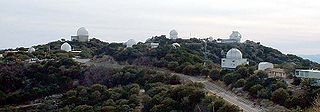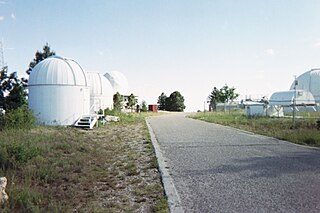Related Research Articles

The Kitt Peak National Observatory (KPNO) is a United States astronomical observatory located on Kitt Peak of the Quinlan Mountains in the Arizona-Sonoran Desert on the Tohono Oʼodham Nation, 88 kilometers (55 mi) west-southwest of Tucson, Arizona. With more than twenty optical and two radio telescopes, it is one of the largest gatherings of astronomical instruments in the Earth's northern hemisphere.

Lowell Observatory is an astronomical observatory in Flagstaff, Arizona, United States. Lowell Observatory was established in 1894, placing it among the oldest observatories in the United States, and was designated a National Historic Landmark in 1965. In 2011, the Observatory was named one of "The World's 100 Most Important Places" by Time Magazine. It was at the Lowell Observatory that the dwarf planet Pluto was discovered in 1930 by Clyde Tombaugh.

Yerkes Observatory is an astronomical observatory located in Williams Bay, Wisconsin, United States. The observatory was operated by the University of Chicago Department of Astronomy and Astrophysics from its founding in 1897 to 2018. Ownership was transferred to the non-profit Yerkes Future Foundation (YFF) in May 2020, which began restoration and renovation of the historic building and grounds. Re-opening for public tours and programming began May 27, 2022.

Steward Observatory is the research arm of the Department of Astronomy at the University of Arizona (UArizona). Its offices are located on the UArizona campus in Tucson, Arizona (US). Established in 1916, the first telescope and building were formally dedicated on April 23, 1923. It now operates, or is a partner in telescopes at five mountain-top locations in Arizona, one in New Mexico, one in Hawaii, and one in Chile. It has provided instruments for three different space telescopes and numerous terrestrial ones. Steward also has one of the few facilities in the world that can cast and figure the very large primary mirrors used in telescopes built in the early 21st century.

The Cerro Tololo Inter-American Observatory (CTIO) is an astronomical observatory located on Cerro Tololo in the Coquimbo Region of northern Chile, with additional facilities located on Cerro Pachón about 10 kilometres (6.2 mi) to the southeast. It is approximately 80 kilometres (50 mi) east of La Serena, where support facilities are located. The site was identified by a team of scientists from Chile and the United States in 1959, and it was selected in 1962. Construction began in 1963 and regular astronomical observations commenced in 1965. Construction of large buildings on Cerro Tololo ended with the completion of the Víctor Blanco Telescope in 1974, but smaller facilities have been built since then. Cerro Pachón is still under development, with two large telescopes inaugurated since 2000, and one in the early stages of construction

Catalina Sky Survey is an astronomical survey to discover comets and asteroids. It is conducted at the Steward Observatory's Catalina Station, located near Tucson, Arizona, in the United States.

Aden B. Meinel was an American astronomer. He retired in 1993 as a distinguished scientist at the Jet Propulsion Laboratory. He also held the rank of professor emeritus at the University of Arizona College of Optical Sciences. His research interests have included upper atmospheric physics, glass technology, optical design, instrumentation and space systems.

A robotic telescope is an astronomical telescope and detector system that makes observations without the intervention of a human. In astronomical disciplines, a telescope qualifies as robotic if it makes those observations without being operated by a human, even if a human has to initiate the observations at the beginning of the night or end them in the morning. It may have software agents using artificial intelligence that assist in various ways such as automatic scheduling. A robotic telescope is distinct from a remote telescope, though an instrument can be both robotic and remote.

The MDM Observatory is an optical astronomical observatory located adjacent to Kitt Peak National Observatory on Kitt Peak, west of Tucson, Arizona, in the United States. It is owned and operated by the University of Michigan, Dartmouth College, Ohio State University, Columbia University, and Ohio University. The Massachusetts Institute of Technology (MIT) was also part of the operating consortium in the past.

The Warner and Swasey Observatory is the astronomical observatory of Case Western Reserve University. Named after Worcester R. Warner and Ambrose Swasey, who built it at the beginning of the 20th century, it was initially located on Taylor Road in East Cleveland, Ohio, USA. The observatory, which at that time housed a 9.5-inch (24 cm) refractor, was donated in 1919 to the Case School of Applied Science. The newer 24-inch (61 cm) Burrell Schmidt telescope was built in 1939.
Warren Rupp Observatory is an astronomical observatory owned and operated by Richland Astronomical Society. Built in 1985, it is located on the Friendly House Hidden Hollow Camp south of Mansfield, Ohio, United States.

Mount Lemmon Observatory (MLO), also known as the Mount Lemmon Infrared Observatory, is an astronomical observatory located on Mount Lemmon in the Santa Catalina Mountains approximately 28 kilometers (17 mi) northeast of Tucson, Arizona (US). The site in the Coronado National Forest is used with special permission from the U.S. Forest Service by the University of Arizona's Steward Observatory, and contains a number of independently managed telescopes.
The McMath-Hulbert Solar Observatory is a solar observatory in Lake Angelus, Michigan, USA. It was established in 1929 as a private observatory by father and son Francis Charles McMath and Robert Raynolds McMath and their friend, Judge Henry Hulbert. In 1932 the observatory was deeded to the University of Michigan which operated it until 1981, at which time it was sold into private ownership again.

The Monterey Institute for Research in Astronomy (MIRA) is an independent, non-profit, professional astronomical observatory dedicated to astronomical education and research, near Monterey, California. It was the first private professional observatory in the United States to open in the 20th century.

Optics Valley is a region in southern Arizona, centered on Tucson, that is home to a high concentration of optics companies spawned by research at the University of Arizona. Based on the idea of a technology cluster such as Silicon Valley, Optics Valley is known not only for its optics industry and research but also for the astronomical observatories located in the mountains of southern Arizona where clear skies and isolated peaks make for superior observing conditions.

Nicholas Ulrich Mayall was an American observational astronomer. After obtaining his doctorate from the University of California, Berkeley, Mayall worked at the Lick Observatory, where he remained from 1934 to 1960, except for a brief period at MIT's Radiation Laboratory during World War II.
The Portage Lake Observatory (PLO) was an astronomical observatory owned and operated by the University of Michigan (UM). It was located near the village of Dexter, Michigan (USA), about 20 kilometers (12 mi) northwest of Ann Arbor. Construction at the site began in 1948, and the facility was closed in 1975.

Catalina Station (CS), also known as Steward Observatory Catalina Station, is an astronomical observing facility located on Mount Bigelow in the Santa Catalina Mountains approximately 29 kilometers (18 mi) northeast of Tucson, Arizona. The site in the Coronado National Forest is used with special permission from the United States Forest Service by the Steward Observatory of the University of Arizona.
Richard Green is an American astronomer, former director of the Kitt Peak National Observatory, UKIRT and the Large Binocular Telescope Observatory.
Sidney Carne Wolff is an American astrophysicist, researcher, public educator, and author. She is the first woman in the United States to head a major observatory, and she provided significant contributions to the construction of six telescopes. Wolff served as Director of the Kitt Peak National Observatory (KPNO) and the National Optical Astronomy Observatory (NOAO). She is a member of the International Astronomical Union's Division G: Stars and Stellar Physics.
References
- ↑ "Don McCarthy". University of Arizona. 2007. Archived from the original on 18 July 2010. Retrieved 5 August 2010.
- ↑ "UA Astronomer Earns National Education Honors". Archived from the original on June 8, 2012. Retrieved 16 February 2012.
{{cite web}}: CS1 maint: unfit URL (link) - ↑ "Education Prize - American Astronomical Society" . Retrieved 16 February 2012.